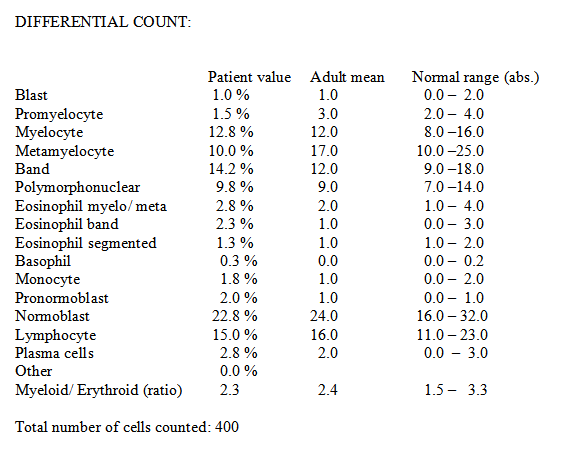
![]() Contributed by Mihaela Avramut, MD, PhD and Raymond E. Felgar, MD, PhD
Contributed by Mihaela Avramut, MD, PhD and Raymond E. Felgar, MD, PhD
CLINICAL HISTORY:
The patient is an 82-year-old man with a history of hypothyroidism and chronic prostatitis, diagnosed with moderate thrombocytopenia on routine complete blood counts. No hepatosplenomegaly or lymphadenopathy were observed. Three months later, thrombocytopenia persisted and a bone marrow biopsy was performed to evaluate for a primary marrow etiology. The following results were reported:
PERIPHERAL BLOOD:

The peripheral blood smear (Fig. 1) showed slight anisocytosis and poikilocytosis, with occasional plasmacytoid lymphocytes and large granular lymphocytes. No pseudo - Pelger-Huet cells or circulating blasts were noted. Platelets were decreased in number, with rare large forms noted.
BONE MARROW:

Bone marrow biopsy, particle sections, and aspirate smears were examined. The marrow was normocellular to mildly hypercellular for age (20-30 % cellular) (Fig. 2), with a myeloid/ erythroid ratio within normal limits (2.3:1). No metastatic tumor, lymphoid infiltrates or granulomas were noted. Erythroid maturation was complete, with only rare nuclear irregularities, involving less than 10% of this lineage (Fig. 4). Complete myeloid maturation to the neutrophil stage was present with no overt dysmyelopoiesis. Megakaryocytes were present in moderately increased numbers, with occasional clustering (Fig. 2 and 3). Megakaryocyte morphology included abnormal forms, with both hypolobated forms and hyperlobated forms.
Reticulin staining showed no overt fibrosis (not shown).
FLOW CYTOMETRY:
Flow cytometric immunophenotypic studies performed on bone marrow aspirate showed approximately 1% CD34-positive myeloblasts, 2% CD117-positive immature myeloid elements, and a population of probable erythroid elements were present. No abnormal T cell or monoclonal B cell population was demonstrated.
CYTOGENETIC STUDIES:
Cytogenetics evaluation of bone marrow demonstrated 5 of 20 metaphases with an abnormal karyotype as follows: 46,XY,del(20)(q11.2q13.3). A representative karyotype is illustrated in Fig. 5.
The other 15 metaphase spreads examined showed a normal male karyotype, 46, XY.